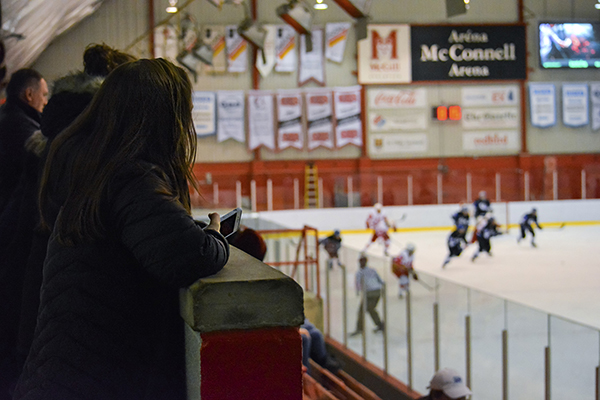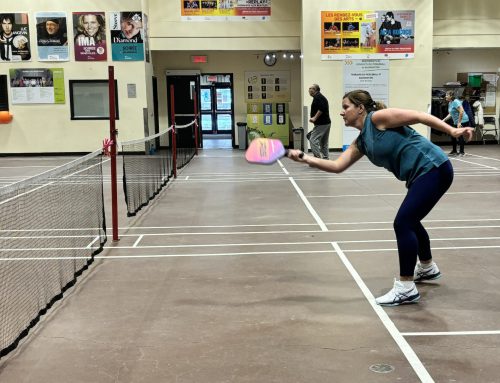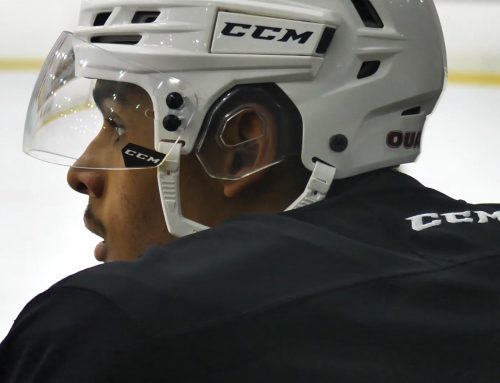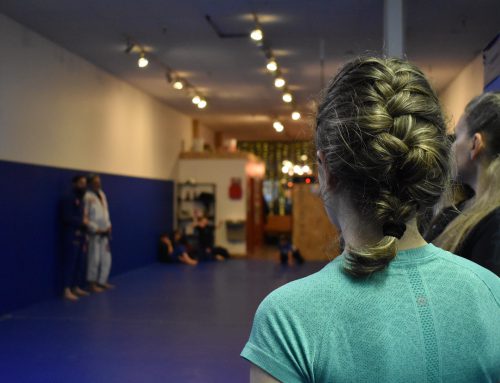BY AMELY COULOMBE & ALEXANDRE ROSS
It’s Friday night and the McGill Martlets women’s hockey team is facing off against the Université de Montréal Carabins. Spectators are coming in groups and the seats keep filling up. Among the spectators, a mix of young girls along with many regulars. Francine Nowacki, mother of one of the Martlet’s coaches, has been coming here for over 10 years.
“This is the best hockey in town,” says Nowacki.
There are only a few seconds left in the first period when Martlets forward Stephanie Desjardins caps off a counterattack and opens the scoring.
Call it a case of ‘She shoots, she scores!’
The crowd erupts. Nowacki’s enthusiasm is noticeable from across the arena as she stands and claps, surrounded by other cheering fans.
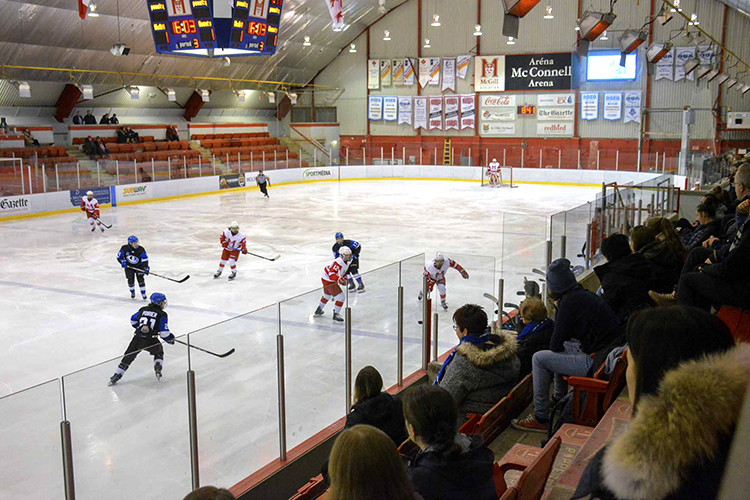
Fans look on as the McGill Martlets play the UdeM Carabins. Tensions ran high in the crowd when UdeM tied the score and brought the game into overtime. Photo by Amely Coulombe.
But it’s hard to be a fan outside the arena as coverage of women’s hockey remains limited.
“Right now, our issue is that we’re not getting enough coverage in terms of visuals,” says Martlets captain Emilia Cotter. “It’s difficult to promote a sport and to increase the number of girls doing it, if there aren’t good visuals.”
Daniela Gendron, who plays defence for the Concordia Stingers women’s hockey team, shares her point of view. “They could always do more, broadcast more games,” says Gendron.
Matthew Ohayon, play-by-play commentator for Concordia, believes that women’s hockey deserves more coverage. “It should and needs to be covered for the growth of the women’s game.”
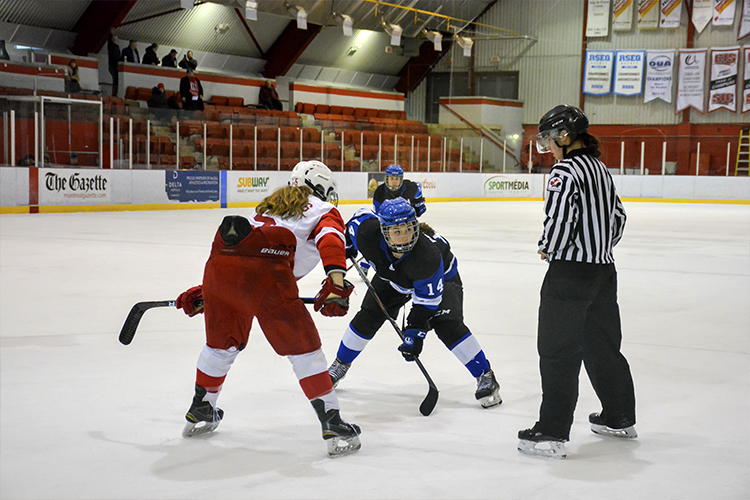
Kess Notargiacomo and Justine Pelletier face off in the second period of the game on Jan. 31. Photo by Amely Coulombe.
Although Canada has the world’s second-ranked team in women’s hockey, it still needs to make a lot more headway before it matches the coverage given to men’s hockey.
“I think that one of the biggest challenges right now is that we want the growth of women’s sports, we want there to be a better product, with more fan base and larger crowds,” says Julie Chu, four-time Olympic medalist and head coach of the Concordia Stingers women’s hockey team. “At the same time, if we don’t actually cover it with the same quality and the same stories and build up the background of why fans should follow the women’s game, then it’s not going to happen.”
In addition to the need for more coverage of games, some say that any coverage at all will help build a bigger fan base.
“We need to know the players, who they are, where they’re from,” says Kevin Raphael, a journalist for TVA Sports who produced a documentary about women’s hockey titled Gap Year. “We need to have an attachment to the players. We need to see them more on talk shows and TV broadcasts. I think it’s absolutely essential that fans are able to become invested in women’s hockey.”
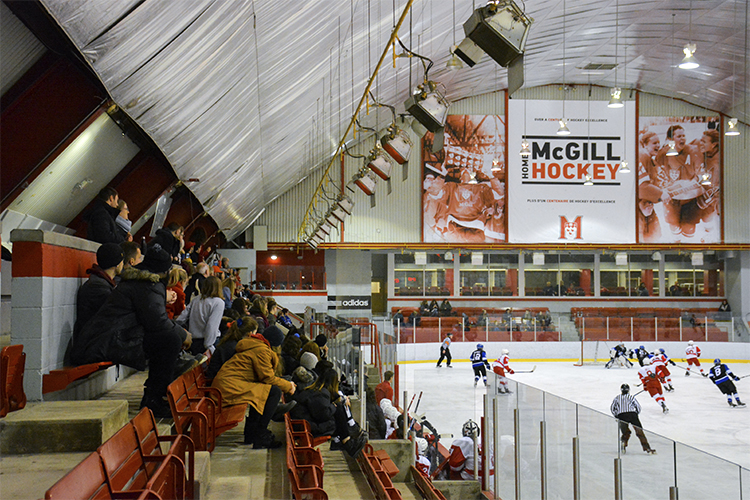
Fans eagerly cheer on McGill and UdeM as the score was tied 2-2 in the third period. McGill was able to secure the win in overtime. Photo by Amely Coulombe.
Fewer fans means less money to keep the sport healthy. Last year, the only professional women’s league in the country, the Canadian Women’s Hockey League (CWHL) folded due to financial difficulties. Many former players and executives of the CWHL believe the lack of media attention contributed to the league’s collapse.
“We need to invest in broadcasters [in women’s hockey] who know the game,” says TVA’s Raphael. “We cannot have somebody there to fill a spot. We need to find the girls who know about women’s hockey.”
With the league gone, many players graduating from college hockey do not have the option to turn pro.
“It’s been very difficult,” says Cotter, who is graduating in 2020. “I don’t want to give up hockey but I feel like I’m almost forced to.”
Even when women’s hockey gets covered, it does not get covered in the same way as the men’s game. In January, the final of the women’s hockey U18 World Championships between Canada and the United States took place in Bratislava, Slovakia. Canada played in the gold medal game, but it wasn’t broadcast on television. Instead, TSN chose to broadcast a quarter-final game from the men’s hockey World Juniors between Sweden and the Czech Republic.
Regular coverage of women’s hockey games will help bring it closer to the forefront, some experts say. Video by Amely Coulombe.
“It’s disrespectful,” says Raphael. “Dis-res-pect-ful. I was very mad.”
A recent petition to broadcast U18 Women’s hockey had over 71,000 signatures. Still, the games weren’t broadcast.
“It’s all money business,” says Nowacki. “They don’t think people want to watch women’s hockey.”
The men’s World Juniors were in a similar situation prior to 1991, when TSN got TV rights to the tournament. Since then, the network has developed their coverage of the event, and the tournament has expanded to become one of the most watched events in Canada.
An overview of the winter sporting events held by the International Ice Hockey Federation. Timeline by Alexandre Ross.
There is the occasional glimmer of hope.
The 2020 NHL All-Star Skills Competition featured a women’s 3-on-3 game between Canada and the United States with some of the best players in the world, such as Rebecca Johnston, Hilary Knight or Marie-Philip Poulin. The game ended in a 2-1 victory for Canada with goals from Johnston and Mélodie Daoust.
“I was really surprised at the high skill level of these women playing hockey,” says Austin Trudeau, a big hockey fan who has traveled to several World Junior Hockey championships. “The main thing I noticed is that, compared to men, all players on the ice are equally talented in stick-handling, they move the puck extremely well and are very fast.”
Trudeau says the three-on-three showcase game was “a great way to start to introduce women’s hockey.”
CBC Sports and U Sports, which oversees university sports in Canada, recently announced a partnership for a free worldwide live streaming of four U Sports national championships. It included the women’s hockey national championship in March. This is a change from previous years where the games were only available on U Sports and required a paid subscription.
“That is a very good step for Canadian university women’s hockey,” says Ohayon.

A women’s hockey player tries to shoot at the net. Photo by Amely Coulombe.
Back at the McGill rink, the game between McGill and Université de Montréal is tied and goes into overtime. It ends with a huge roar from Martlet fans as McGill scores to win the game.
Now the team is setting its sights on getting back into the final of the national championship.
They lost the final last year. But any revenge would add a little extra spice this year, as the game is broadcast across the country on the CBC.
